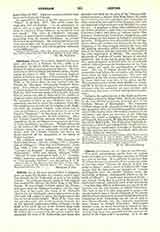

Oxford, one of the most ancient cities in England, grew up under the shadow of a convent, said to have been founded by St. Frideswide as early as the eighth century. Its authentic history begins in 912, when it was occupied by Edward the Elder, King of the West Saxons. It was strongly fortified against the Danes, and again after the Norman Conquest, and the massive keep of the castle, the tower of St. Michael’s Church (at the north gate), and a large portion of the city walls still remain to attest the importance of the city in the eleventh century. West of the town rose the splendid castle, and, in the meadows beneath, the no less splendid Augustinian Abbey of Oseney: in the fields to the north the last of the Norman kings built the stately palace of Beaumont; the great church of St. Frideswide was erected by the canons-regular who succeeded the nuns of St. Frideswide; and many fine churches were built by the piety of the Norman earls. Oxford received a charter from King Henry II, granting its citizens the same privileges and exemptions as those enjoyed by the capital of the kingdom; and various important religious houses were founded in or near the city. A grandson of King John established Rewley Abbey (of which a single arch now remains) for the Cistercian Order; and friars of various orders (Dominicans, Franciscans, Carmelites, Augustinians, and Trinitarians), all had houses at Oxford of varying importance. Parliaments were often held in the city during the thirteenth century, but this period also saw the beginning of the long struggle between the town and the growing university which ended in the subjugation of the former, and the extinction for centuries of the civic importance of Oxford. The accession of thousands of students of course brought it material prosperity, but it was never, apart from the university, again prominent in history until the seventeenth century, when it became the headquarters of the Royalist party, and again the meeting-place of Parliament. The city of Oxford showed its Hanoverian sympathies long before the university, and feeling between them ran high in consequence. The area and population of the city remained almost stationary until about 1830, but since then it has grown rapidly. The population is now (1910) about 50,000; the municipal life of the city is vigorous and flourishing, and its relations with the university are more intimate and cordial than they have ever been during their long history.
Oxford is the cathedral city of the Anglican Diocese of Oxford, erected by Henry VIII. Formerly included in the vast Diocese of Lincoln, it is now part of the Catholic Diocese of Birmingham. The handsome Catholic church of St. Aloysius (served by the Jesuits) was opened in 1875; the Catholic population numbers about 1200, besides about 100 resident members of the university; and there are convents of the following orders—St. Ursula’s, Daughters of the Cross, Sisters of Nazareth, Sisters of the M. Holy Sacrament, and Sisters of the Holy Child. The Franciscan Capuchin fathers have a church and college in the suburb of Cowley, as well as a small house of studies in Oxford; and the Benedictines and Jesuits have halls, with private chapels, within the university.
D. O. HUNTER-BLAIR

